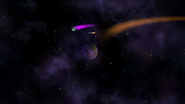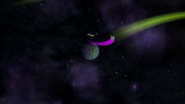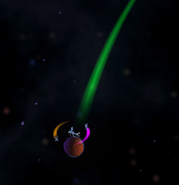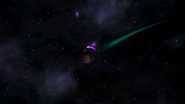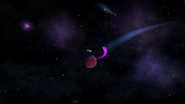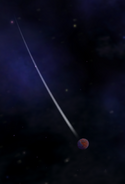|
This article requires cleanup for quality standards and clarity. Feel free to help out! |
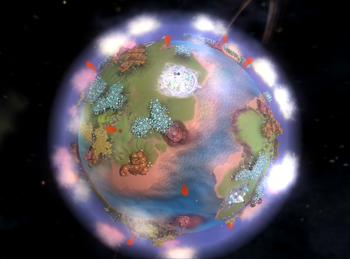
A typical planet in Spore.
Planets can be found orbiting stars all throughout the galaxy, and every saved game starts out on one of them. In the Space Stage, planets can be colonized to spread your empire's territory, and to harvest Spice. Planets come in a wide variety of forms, and have diverse terrain like mountains, oceans, rivers, etc. They can also generate with rings, but these are purely cosmetic.
The vast majority of planets found in the space stage are terrascore zero (uninhabitable). But, you may also find planets with a more suitable atmosphere and temperature. These planets often just have flora, but sometimes you may find creatures, or even other species that have advanced into tribes or civilizations.
Gas giant planets also appear frequently in the Space Stage, however these planets cannot be visited or colonized. They frequently have moons around them however, which do count as valid rocky planets you can go to.
With the exception of the Sol system, all planets in Spore are procedurally generated with random features and surface conditions.
Forms[]
Barren planets/dead planets[]
- Ice planet - A cold planet with an extreme amount of ice on its surface.
- Lava planet - A hot planet where lava and fiery clouds have formed on its surface.
- Rocky planet - A dry planet with nothing but rock and dirt on its surface.
- Water planet - A humid planet with an extreme amount of water on the surface.
- Flurry planet - A cold planet with no ice on the surface, which is primarily rock.
- Arid planet - A hot planet with no liquid water, and sand covering the surface.
- Boiling planet - A planet that still has liquid water, but which is starting to boil.
- Melting planet - A planet that has ice on its surface, but also has patches of liquid water.
- Gas giant - A planet that cannot be colonized (not even visited), but usually has moons.
Habitable planets[]
- Homeworld - The planet in which creature has developed in the previous stages. Multiple empires, and other races may have T3 homeworlds. T3 and Civilization stage homeworlds have a number of cities not obtainable in an ordinary planet. T1 and T2 space stage will have only one or two cities, they are simply glorified T1/T2 planets.
- Category-1 planet - A planet with a little life, acceptable atmosphere and temperature. (T1)
- Category-2 planet - A planet with a good amount of life, good atmosphere and temperature. (T2)
- Category-3 planet - A planet flourishing with life, has perfect atmosphere and perfect temperature. (T3)
Other Types[]
- Cube planet - A cube-shaped planet added in Patch 1.02.
- Storybook planets - A specially sculpted planet with strange features ranging from gears to croissants. They are very, very rare.
- Crater planet - A planet with an astonishing amount of craters.
- Ruined Planet - Found on the player's second mission, a few piles of rubble found on the surface. Rarely you will find ruins on other planets. It's unknown if this is a glitch or not.
- Saved Game - Another Spore Game of the player's.
- Unnatural planets - Strange planets with impossible geology.
- Adventure planets - Planets with an adventure in it. The information that appears in the solar view does not correlate with the adventure's actual appearance.
- Moons - Moons can be terraformed into habitable places.
- Asteroids and comets - Other planetary bodies in most star systems.
- Destroyed planets - These planets have been destroyed by a Planet Buster. They look like stars shrunk to planetary size. They eventually fade away.
- Atoll Planets - Planets almost completely covered in water, with very little land to place colonies on.
Player-Created Planets[]
- While vanilla Spore does not have a planet editor, players are able to customize planets with the planet sculpting, coloring, and atmospheric tools. These allow players to modify the planet's colors, terrain shape, climate, etc. However, making large changes to the terrain (such as adding a continent) would probably be impractical, due to the limited scope of tools available.
- The Galactic Adventures expansion pack introduces the Adventure Creator, an editor that can create adventure planets which can be uploaded to the Sporepedia. However, the Adventure Creator cannot be used to modify non-adventure planets.
Planet Dangers[]
All T0 planets have two dangers. Lava planets have Fire Storms and Fire Jets. Arid planets have Fire Jets and Meteor Showers. Rocky planets have Rock Geysers and Meteor Showers. Flurry planets have Ice Geysers and Meteor Showers. Ice planets have Ice Geysers and Electric Storms. Water planets have Electric Storms and Whirlwinds. Boiling planets have Electric Storms and Fire Jets. Occasionally a planet will have an Epic Creature on the surface. Homeworlds often have volcanoes on their surface as well, but oddly enough they cause no damage to your ship, although it looks as if they do. Be warned that the damage from planets affect a percentage of your health, not a certain amount.
Threats[]
| Threats | Minor Damage | Medium Damage | Major Damage |
|---|---|---|---|
| Fire Storms | - | X | X |
| Fire Jets | X | X | - |
| Meteor Showers | - | X | - |
| Rock Geysers | X | - | - |
| Ice Geysers | X | X | - |
| Electric Storms | - | X | X |
| Whirlwinds | X | X | - |
| Epics | - | - | X |
Orbits[]
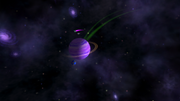
Moon (upper) and planet (lower) orbit tractors.
Every planet has a fixed orbit, and the shorter the distance between the planet and the star, the smaller the orbit will be (and hence the less time required for the planet to go around the star once). There are six types of orbits in the game, ordered in distance from the star. Starting from the closest, they are orange, green, lime, turquoise, blue and white. The color of the trail indicates which type of orbit the planet is in.
Gas giants normally have blue orbits. Sometimes they have green orbits, and are rarely found in orange orbits. They can also be found in the other orbits colors
Moons always have the same type of orbit as the planet around which they orbit, but their orbits are shorter and more transparent than those of planets.
Orange[]
Planets with the orange orbit are closest to the star. These planets are always hot and tend to be boiling or lava planets. They generally lack an atmosphere. The ground is usually red or pink, and the seas tend to be red.
Green[]
Planets in green orbits are more easily terraformed (and hence are easier to colonize). In addition, these planets may already have life on them. Homeworlds usually have green orbits, though rarely they might be orange or blue due to a glitch.
Lime[]
Lime orbits are the second rarest orbits in the galaxy. Planets in lime orbits generally are T3 planets with flourishing life, therefore, fully terraformed and a perfect place to colonize. Lime orbit planets can be generally made by terraforming a green orbit planet into T3. Then, it might turn into a lime orbit planet.
Turquoise[]
Turquoise orbits are the third rarest orbits in the galaxy. These orbits are somewhere between the green and blue orbits, and planets with these orbits exhibit some of the characteristics of planets in both blue and green orbits. The color of their atmosphere, water and land varies greatly.
Blue[]
Because planets in blue orbits are far away from the star, they are always cold and are normally covered in ice. These planets tend to have gray-colored land and often have no atmosphere.
White[]
White orbits are the rarest in the Spore galaxy, and only exist in Binary OO systems (double blue stars). They are extremely hard to terraform; the second you stop terraforming, the T-score will immediately drop to where it was before (usually the lower left). Even when using the Staff of Life, the planet will try and force itself down to T0, meaning that they have very fragile ecosystems. Their orbital color will change to pale grayish blue when it is closest to its star and back to white when it moves farther out into its orbit, as these planets, as well as many others, have irregular orbits.

